-
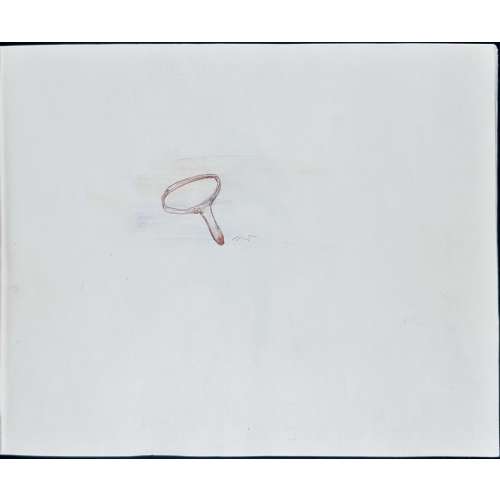 NEWAlbum of 17 watercolour drawings on thick wove paper sheets 265 x 205 mm, incl. title and colophon, in Japanese stab binding — cardboard covers with yellow and grey stripes sewed with pink thread. Signed and dated. The conditional title of the album may be "Girl's Toy". Artist: Otto Rudolf Schatz (Austrian, 1900 – 1961).
NEWAlbum of 17 watercolour drawings on thick wove paper sheets 265 x 205 mm, incl. title and colophon, in Japanese stab binding — cardboard covers with yellow and grey stripes sewed with pink thread. Signed and dated. The conditional title of the album may be "Girl's Toy". Artist: Otto Rudolf Schatz (Austrian, 1900 – 1961). -
 NEWTwelve drypoint plates, incl. the title, with plate marks at 90 x 70 mm, unsigned, in Japanese style binding — sewed cardboard covers with blue and green diaper design 195 x 142 mm; blank fly leaves in the front and the rear. Dorotheum GmbH selling slip laid in. The number of printed copies is unknown to us. Artist: Otto Rudolf Schatz (Austrian, 1900 – 1961).
NEWTwelve drypoint plates, incl. the title, with plate marks at 90 x 70 mm, unsigned, in Japanese style binding — sewed cardboard covers with blue and green diaper design 195 x 142 mm; blank fly leaves in the front and the rear. Dorotheum GmbH selling slip laid in. The number of printed copies is unknown to us. Artist: Otto Rudolf Schatz (Austrian, 1900 – 1961). -
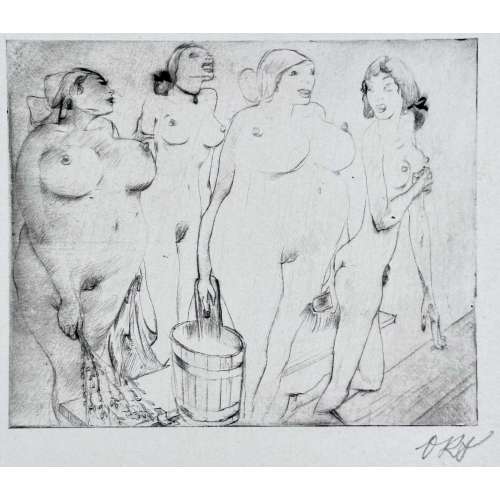 NEWDrypoint on cream cardstock 208 x 207 mm with platemark 100 x 122 mm, monogrammed "ORS" in pencil outside the plate. Artist: Otto Rudolf Schatz (Austrian, 1900 – 1961).
NEWDrypoint on cream cardstock 208 x 207 mm with platemark 100 x 122 mm, monogrammed "ORS" in pencil outside the plate. Artist: Otto Rudolf Schatz (Austrian, 1900 – 1961). -
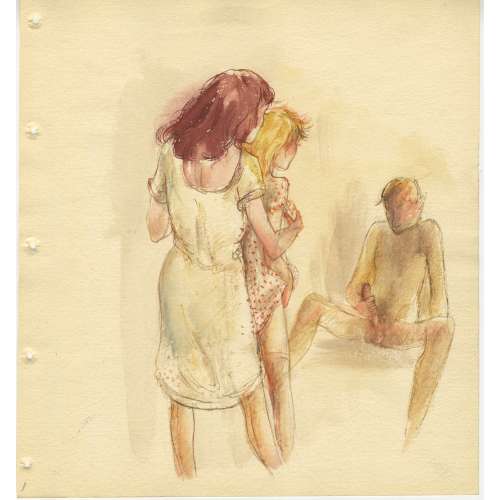 NEWEleven loose sheets, approx. 250 x 230 mm each, numbered in the bottom left corner in pencil (by owner?), with five binding holes in the left margin, traces of passe-partout mounting to verso; no title sheet. It is probably a disbound watercolour album telling the same story as the printed Der Kleine Bruder (see SVE-0581.2024). Artist: Otto Rudolf Schatz (Austrian, 1900 – 1961).
NEWEleven loose sheets, approx. 250 x 230 mm each, numbered in the bottom left corner in pencil (by owner?), with five binding holes in the left margin, traces of passe-partout mounting to verso; no title sheet. It is probably a disbound watercolour album telling the same story as the printed Der Kleine Bruder (see SVE-0581.2024). Artist: Otto Rudolf Schatz (Austrian, 1900 – 1961). -
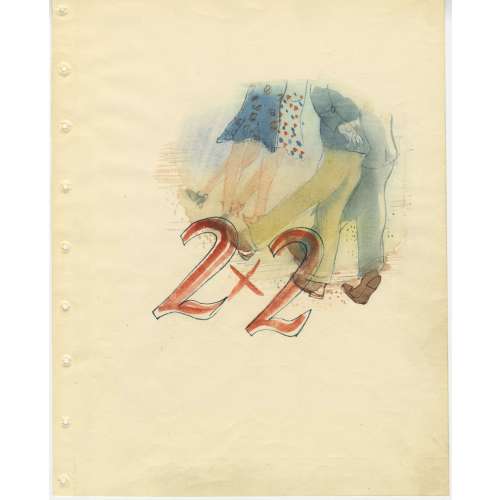 NEWTwo loose sheets, one 295 x 235 mm and another, the title page, 295 x 470 mm, folded in half with the image on one side only, leaves pierced for being bound in an album. Artist: Otto Rudolf Schatz (Austrian, 1900 – 1961).
NEWTwo loose sheets, one 295 x 235 mm and another, the title page, 295 x 470 mm, folded in half with the image on one side only, leaves pierced for being bound in an album. Artist: Otto Rudolf Schatz (Austrian, 1900 – 1961). -
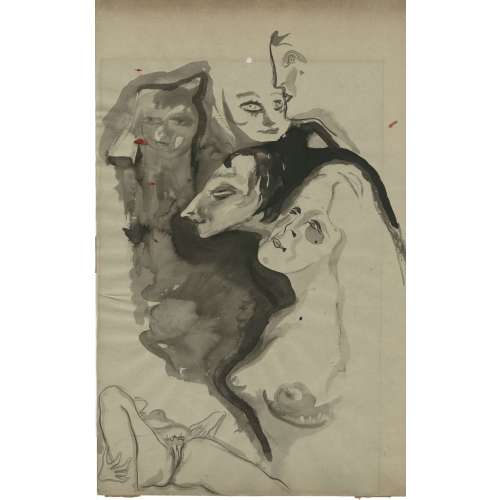 NEW"The Jewish Hungarian artist Nicolas Sternberg moved to Paris in the 1920s, remaining there for the rest of his life, hiding during the German occupation of the city in the 1940s under false identity papers". [MIA: Minneapolis Institute of Art, cited] Jean-Pierre Dutel provides the following information: Nicolas Sternberg was born to Jewish parents on July 9, 1902, in Nagyvárad, in Austro-Hungary. According to the archives of the Préfecture de police in Paris (1930), he was Hungarian. His real name was Miklós Szines-Sternberg. At the time, it was common among painters and sculptors to retain their original German names while adopting Hungarian-German double surnames. From age twelve, he worked as a newspaper illustrator in Budapest before moving to Paris in the early 1920s after studying in Munich. He published regularly in Paris-Soir, one of the most important French daily newspapers between the wars. Despite his talent, only one solo exhibition seems to have been dedicated to him at the Galerie Georges Petit (Georges Petit, 1856–1920) in 1929. Jules Pascin (1885 –1930) exhibited there in 1930 and committed suicide on the opening day. Sternberg is known for his drawings devoted to the circus, madmen, and pornography. He excelled in portraits and self-portraits, particularly fine portraits of his wife Miche and his friend Michel Simon (1895–1975). In 1927, he made drawings for Les Flambeaux de la Noce, a play at the Comédie-Française. He also contributed to the illustration of La Légende des sexes by Edmond Haraucourt (1856 –1941). In 1930, he created illustrations for Les Aventures du Roi Pausole by Pierre Louÿs (1870–1925), published by Simon Kra (1853–1940), and for an edition of the bawdy songs Les Trois Orfèvres à la Saint Éloi, which led to an investigation into its publisher and illustrator. He also produced original watercolours for an edition of Manuel de Civilité by Pierre Louÿs. In 1933, he illustrated Madame de Pompadour by Paul Reboux (1877 –1963). In 1937, Sternberg illustrated Souls and Secrets, a collection of Hasidic stories by József Patai (1882–1953), translated by his son, the anthropologist, ethnologist, and historian Raphael Patai (Budapest, 1910 – Tucson, 1996), who kept some of Sternberg’s works in his home. Portraits of Michel Simon dating from 1932, along with numerous pornographic photographs of Sternberg taken by the actor between 1940 and 1960, demonstrate the longevity of their relationship. In 1940, Sternberg miraculously escaped the Nazi’s aerial bombardment that killed several members of his family. During the Occupation, he lived in hiding with false papers and resumed his career in Paris after the war. Despite visual differences, Jules Pascin and Nicolas Sternberg shared some curious similarities. Their works, though employing different techniques, reflect the same underlying despair. Like Pascin, Sternberg committed suicide.
NEW"The Jewish Hungarian artist Nicolas Sternberg moved to Paris in the 1920s, remaining there for the rest of his life, hiding during the German occupation of the city in the 1940s under false identity papers". [MIA: Minneapolis Institute of Art, cited] Jean-Pierre Dutel provides the following information: Nicolas Sternberg was born to Jewish parents on July 9, 1902, in Nagyvárad, in Austro-Hungary. According to the archives of the Préfecture de police in Paris (1930), he was Hungarian. His real name was Miklós Szines-Sternberg. At the time, it was common among painters and sculptors to retain their original German names while adopting Hungarian-German double surnames. From age twelve, he worked as a newspaper illustrator in Budapest before moving to Paris in the early 1920s after studying in Munich. He published regularly in Paris-Soir, one of the most important French daily newspapers between the wars. Despite his talent, only one solo exhibition seems to have been dedicated to him at the Galerie Georges Petit (Georges Petit, 1856–1920) in 1929. Jules Pascin (1885 –1930) exhibited there in 1930 and committed suicide on the opening day. Sternberg is known for his drawings devoted to the circus, madmen, and pornography. He excelled in portraits and self-portraits, particularly fine portraits of his wife Miche and his friend Michel Simon (1895–1975). In 1927, he made drawings for Les Flambeaux de la Noce, a play at the Comédie-Française. He also contributed to the illustration of La Légende des sexes by Edmond Haraucourt (1856 –1941). In 1930, he created illustrations for Les Aventures du Roi Pausole by Pierre Louÿs (1870–1925), published by Simon Kra (1853–1940), and for an edition of the bawdy songs Les Trois Orfèvres à la Saint Éloi, which led to an investigation into its publisher and illustrator. He also produced original watercolours for an edition of Manuel de Civilité by Pierre Louÿs. In 1933, he illustrated Madame de Pompadour by Paul Reboux (1877 –1963). In 1937, Sternberg illustrated Souls and Secrets, a collection of Hasidic stories by József Patai (1882–1953), translated by his son, the anthropologist, ethnologist, and historian Raphael Patai (Budapest, 1910 – Tucson, 1996), who kept some of Sternberg’s works in his home. Portraits of Michel Simon dating from 1932, along with numerous pornographic photographs of Sternberg taken by the actor between 1940 and 1960, demonstrate the longevity of their relationship. In 1940, Sternberg miraculously escaped the Nazi’s aerial bombardment that killed several members of his family. During the Occupation, he lived in hiding with false papers and resumed his career in Paris after the war. Despite visual differences, Jules Pascin and Nicolas Sternberg shared some curious similarities. Their works, though employing different techniques, reflect the same underlying despair. Like Pascin, Sternberg committed suicide. -
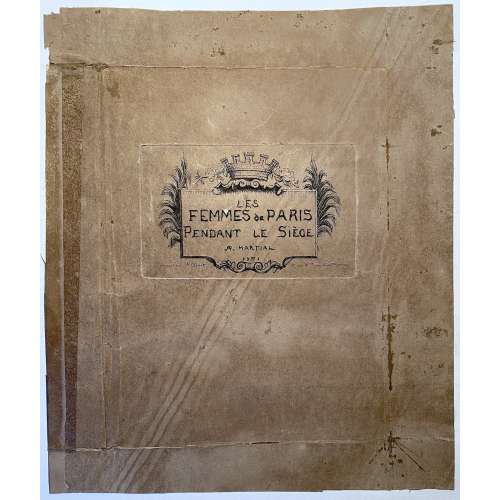 A suite of 12 etchings 160 x 118 mm each, in the first state, pasted on paper, 2 per sheet, with a cover (250 x 210 mm).0. Cover. Les femmes de Paris pendant le siège./R.Martial/1871.1. Lorsqu'à l'approche de l'ennemi on demandait l'éloignement des bouches inutiles [...] 2. L'Ennemi ! 3. No inscription 4. Quête pour les veuves. 5. Concert et quête pour les enfants blessés, malades, infirmes. 6. Au bastion/Et celles non moins précieuses qui dirigeaient ces ventes [...] 7. Vente pour les orphelins de la guerre. 8. No inscription 9. Une ration, bouillie romaine et Vin/Cantine municipale[...] 10. No inscription 11. No inscription 12. Les effets de cette union patriotique des femmes sont connus.[...]
A suite of 12 etchings 160 x 118 mm each, in the first state, pasted on paper, 2 per sheet, with a cover (250 x 210 mm).0. Cover. Les femmes de Paris pendant le siège./R.Martial/1871.1. Lorsqu'à l'approche de l'ennemi on demandait l'éloignement des bouches inutiles [...] 2. L'Ennemi ! 3. No inscription 4. Quête pour les veuves. 5. Concert et quête pour les enfants blessés, malades, infirmes. 6. Au bastion/Et celles non moins précieuses qui dirigeaient ces ventes [...] 7. Vente pour les orphelins de la guerre. 8. No inscription 9. Une ration, bouillie romaine et Vin/Cantine municipale[...] 10. No inscription 11. No inscription 12. Les effets de cette union patriotique des femmes sont connus.[...] -
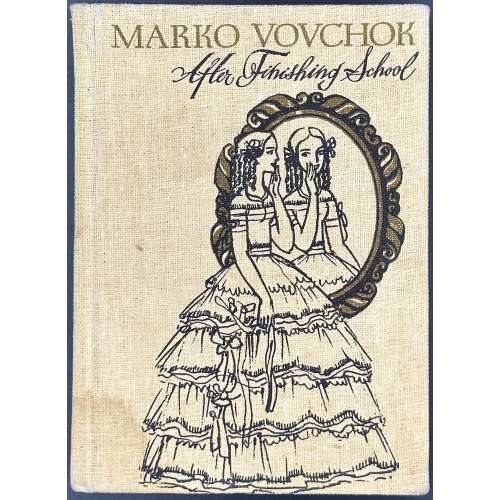 Small volume, 14 x 10 cm, in tan cloth with vignette and lettering to front, lettering to spine, pp.: [1-4] 5-123 [5], total 64 leaves, 10 full-page and 7 double-page two-colour woodcuts within pagination, and numerous b/w in-text vignettes by Serhiy Adamovych; translated from the Ukrainian into English by Oles Kovalenko. Print run: 11,000 copies. Contributors: Марко Вовчок [Marko Vovchok; Марія Олександрівна Вілінська] (Ukrainian, 1833 – 1907) – author. Other variants: Markowovzok and Marko Vovtchok. Олесь Iванович Коваленко (Ukrainian, 1945 – 2012) – translator from the Ukrainian into English. Сергiй Тадейович Адамович [Serhiy Adamovych] (Ukrainian, 1922 – 1998) – artist.
Small volume, 14 x 10 cm, in tan cloth with vignette and lettering to front, lettering to spine, pp.: [1-4] 5-123 [5], total 64 leaves, 10 full-page and 7 double-page two-colour woodcuts within pagination, and numerous b/w in-text vignettes by Serhiy Adamovych; translated from the Ukrainian into English by Oles Kovalenko. Print run: 11,000 copies. Contributors: Марко Вовчок [Marko Vovchok; Марія Олександрівна Вілінська] (Ukrainian, 1833 – 1907) – author. Other variants: Markowovzok and Marko Vovtchok. Олесь Iванович Коваленко (Ukrainian, 1945 – 2012) – translator from the Ukrainian into English. Сергiй Тадейович Адамович [Serhiy Adamovych] (Ukrainian, 1922 – 1998) – artist. -
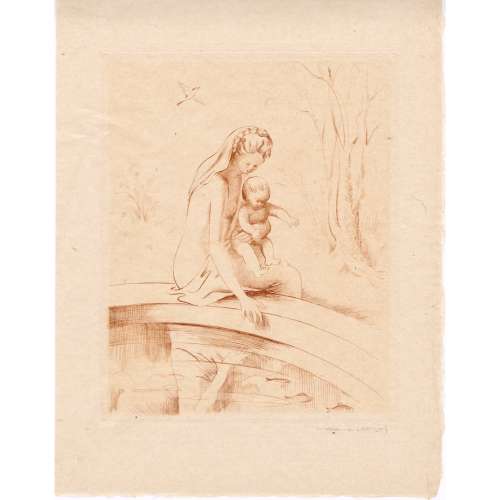 Set of 10 etchings (9 in passe-partout) printed in sanguine on the mother of pearl paper (japon nacre) from the album of 12 prints titled “Jeunesse”, presented by Gérard D'Houville (pen name of Marie de Régnier, née de Heredia) and published by La Tradition in 1945. It was a limited edition of 532 copies, some coloured on Arches paper and some as these set. Plates signed by the artist in pencil below the plate mark. The album cover is missing. Title-page: JEUNESSE | 12 EAUX-FORTES ORIGINALES | DE | MARIANNE CLOUZOT | PRÉSENTÉES | PAR | GÉRARD D'HOUVILLE | {publisher’s device} | LA TRADITION | 1945 || Dimensions: mat 330 x 255 mm; window 225 x 180 mm; sheet 280 x 220 mm; plate 220 x 170 mm. Contributors: Marianne Clouzot (French, 1908 – 2007) – artist Marie de Régnier [Marie de Heredia, Gérard d'Houville] (French, 1875 – 1963) – editor
Set of 10 etchings (9 in passe-partout) printed in sanguine on the mother of pearl paper (japon nacre) from the album of 12 prints titled “Jeunesse”, presented by Gérard D'Houville (pen name of Marie de Régnier, née de Heredia) and published by La Tradition in 1945. It was a limited edition of 532 copies, some coloured on Arches paper and some as these set. Plates signed by the artist in pencil below the plate mark. The album cover is missing. Title-page: JEUNESSE | 12 EAUX-FORTES ORIGINALES | DE | MARIANNE CLOUZOT | PRÉSENTÉES | PAR | GÉRARD D'HOUVILLE | {publisher’s device} | LA TRADITION | 1945 || Dimensions: mat 330 x 255 mm; window 225 x 180 mm; sheet 280 x 220 mm; plate 220 x 170 mm. Contributors: Marianne Clouzot (French, 1908 – 2007) – artist Marie de Régnier [Marie de Heredia, Gérard d'Houville] (French, 1875 – 1963) – editor -
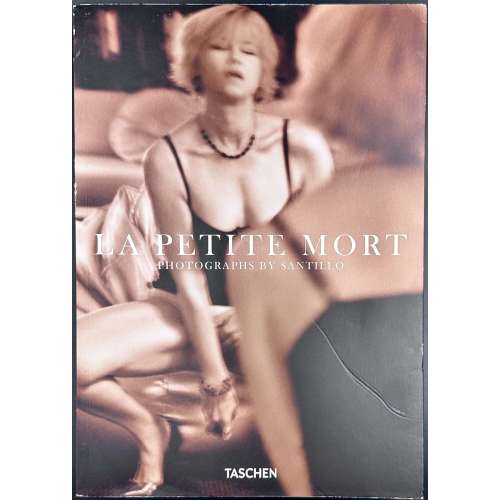 Softcover, 290 x 205 mm, publisher’s flapped pictorial wrappers, pp.: [1-7] 8-205 [3], text in English, French, and German, profusely illustrated. First edition published in 2011. Title-page: Edited by Dian Hanson | LA | PETITE | MORT | § | PHOTOGRAPHS BY SANTILLO | TASCHEN || Hanson, Dian (American, b. 1951) – editor/text Santillo, William (American) – photographer
Softcover, 290 x 205 mm, publisher’s flapped pictorial wrappers, pp.: [1-7] 8-205 [3], text in English, French, and German, profusely illustrated. First edition published in 2011. Title-page: Edited by Dian Hanson | LA | PETITE | MORT | § | PHOTOGRAPHS BY SANTILLO | TASCHEN || Hanson, Dian (American, b. 1951) – editor/text Santillo, William (American) – photographer


